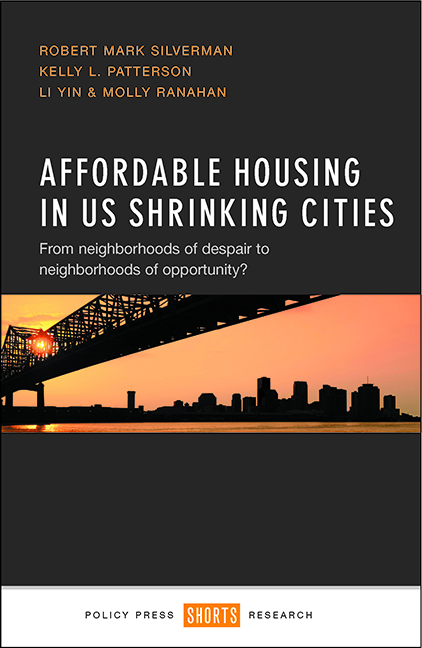 Affordable Housing in US Shrinking Cities
Affordable Housing in US Shrinking Cities Book contents
- Frontmatter
- Contents
- List of tables
- List of figures
- List of acronyms
- About the authors
- Acknowledgments
- Preface
- 1 Social equity and siting affordable housing in shrinking cities
- 2 Present-day Detroit
- 3 Present-day New Orleans
- 4 Present-day Cleveland
- 5 Present-day Pittsburgh
- 6 Present-day Buffalo, New York
- 7 Lessons learned and recommendations for siting affordable housing
- References
- Index
2 - Present-day Detroit
Published online by Cambridge University Press: 01 September 2022
- Frontmatter
- Contents
- List of tables
- List of figures
- List of acronyms
- About the authors
- Acknowledgments
- Preface
- 1 Social equity and siting affordable housing in shrinking cities
- 2 Present-day Detroit
- 3 Present-day New Orleans
- 4 Present-day Cleveland
- 5 Present-day Pittsburgh
- 6 Present-day Buffalo, New York
- 7 Lessons learned and recommendations for siting affordable housing
- References
- Index
Summary
Introduction
This chapter examines Detroit, the quintessential shrinking city in the US. It begins with a discussion of the structural causes of the city’s population decline. This discussion highlights how postwar deindustrialization and suburbanization set the stage for Detroit’s decline. The acceleration of these processes helped to form the conditions that sparked the 1967 Detroit riots. In response to it and other urban unrest during the 1960s, national affordable housing reforms and other policies were proposed to address race and class inequality in American cities. After reviewing the foundations for Detroit’s inequality and decline, data are presented which show persistent race and class segregation in the metropolitan area. It is argued that these conditions continue to impact residents’ access to housing and institutional resources into the contemporary period.
After examining regional population and housing characteristics, the chapter explores conditions in the area of Detroit where eds and meds revitalization strategies have been adopted. The neighborhood characteristics where anchor-based strategies have been applied are contrasted with the rest of the city. This analysis includes an examination of the composition of Department of Housing and Urban Development (HUD)-subsidized housing in areas slated for eds and meds revitalization. This focus is used in order to gain insights into the degree to which the preservation and expansion of affordable housing was factored into anchor-based revitalization strategies. This topic is explored in greater detail in the final section of the chapter.
Detroit in the wake of sustained shrinking
Where things stand in Detroit
In his book The Origins of the Urban Crisis, Surgue (1996) chronicled the fall of Detroit during the postwar era. He vividly describes the city’s decline in these terms:
In the 1940s, Detroit was America’s “arsenal of democracy,” one of the nation’s fastest growing boomtowns and home of the highest-paid blue-collar workers in the United States. Today, the city is plagued by joblessness, concentrated poverty, physical decay, and racial isolation. Since 1950, Detroit has lost nearly a million people and hundreds of thousands of jobs. Vast areas of the city, once teeming with life, now stand abandoned. (Surgue 1996: 3)
- Type
- Chapter
- Information
- Affordable Housing in US Shrinking CitiesFrom Neighborhoods of Despair to Neighborhoods of Opportunity?, pp. 23 - 46Publisher: Bristol University PressPrint publication year: 2016


